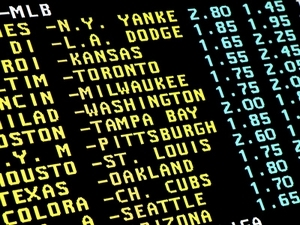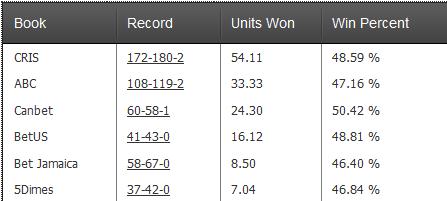“Betting Units Won” Explained
How to Bet On Sports > Betting Units Won Explained
 While winning percentage may be the first stat you see when evaluating sports bets, Betting Units Won is the most important number when evaluating a betting system or handicapper’s true worth. Units Won is the amount of money a group of plays won or lost after factoring in juice. It is a simple way to compare a group of plays regardless of a player’s bankroll.
While winning percentage may be the first stat you see when evaluating sports bets, Betting Units Won is the most important number when evaluating a betting system or handicapper’s true worth. Units Won is the amount of money a group of plays won or lost after factoring in juice. It is a simple way to compare a group of plays regardless of a player’s bankroll.
To determine the betting units won on different juices you can use the formula below (where x = odds.)
• if x > 0 use, (x/100)
• if x < 0 use, (-100/x)
If North Carolina is a 3-point favorite over Duke with the juice at -115, then you would use -115 for x in the in the second formula.
(-100/-115) = 0.8696
If North Carolina covered the spread, you would have won +0.87 “units” for that play. If UNC doesn’t cover, you would lose one unit or -1 “units”.
At Sports Insights, our goal is to help members make more-informed decisions. We make it simple to follow plays and try to be as transparent as possible with our results. We bet a single “unit” on each of our Betting System plays factoring in the juice to calculate the amount won or lost on each play. We never change the bet amount, which allows members to compare apples to apples when evaluating our results across seasons and betting systems, many of which go back to 2003.
On the site you’ll see results for our Betting Systems displayed in boxes like the one below. We make it easy for members to gauge a strategy’s true worth by doing the “Units Won” calculations for you. To calculate your earnings, simply multiply your standard wager by the units won.
From the table above a $50 bettor would be up $340.00 at this point on the season for the NFL Steam Moves. [6.8 (units) x $50 = $340.00]
At Sports Insights, we recommend using a standard bet amount for all of your plays. We suggest using 2% of your bankroll for each selection, but some people like to use up to 5%. Whatever percentage you choose, keep it consistent throughout the season. This will allow you to spread out your risk and ride the highs and lows of the sports betting marketplace to turn a profit. If you are enjoying a good season early on, be careful about increasing your bet amount. If this is the case, we recommend only altering it once at around mid-season, and keeping it the same percentage of your new bankroll.
Not all “Units Won” are created equal. Betting Units Won is abused by handicappers so much that is has little or no worth on most handicapping sites. They may use a 10- or 20-unit bet for most plays, but then make 100-unit “locks” to inflate their results or as a dubious attempt to get back to even on the season for advertising purposes. Unless a handicapper clearly defines how they calculate their units won, and uses a standard bet amount throughout the season, don’t believe a word they say.
Betting Units Won vs. Winning Percentage
While both “Units Won” and winning percentage can be telling when evaluating a group of plays, the sample size (number of plays) is also an important piece of information to look at. Some bettors use a strategy that is referred to as the Wal-Mart approach. With this strategy, bettors are hoping to grind out a profit through a higher quantity of plays, which allows bettors to spread around their risk in the sports betting marketplace.
In the table above, Pinnacle has a lower winning percentage than Phoenix, but it also has a higher profit for the season due to triggering more than double the number of plays. Spreading risk around allows bettors to ride the highs and lows of the season and still turn a profit. This approach requires bettors to be steadfast with their betting amounts. At Sports Insights, we recommend using 2% of your starting bankroll for each wager. (For more information, read Betting Unit Size.) Fluctuations in your standard bet will most likely cause more damage during the lows than it will help during the highs.
Spreading the risk around in the sports betting marketplace is similar to building a diverse portfolio in the stock market. It lessens the damage done by a rough stretch in the market. If a bettor is starting out with a $100 bankroll, and decides to use $25 wagers, there is a good chance the bankroll would be decimated by an early cold streak. However, if that same bettor makes $2 wagers, he can withstand any early cold streaks to remain in the market and realize positive gains. For example, Sports Insights betting strategies will produce 5-10 plays on an average day with an expected 54-55% win percentage. Instead of betting two games at $50 each, we suggest you bet 2% of your bankroll on 10 plays.
Moneyline Sports vs. Spread Sports
Many bettors like to stay away from moneyline-based sports, such as baseball and hockey, due to the extremes in winning percentages, but they can be very profitable. Betting on the underdog in moneyline sports will likely give you a losing record, but the payouts for winners will be so much higher that your profits will increase. Below is a section of a results page for MLB Smart Money plays. Notice that five out the six books have losing records for the triggered plays, but that all six have significant units won due to underdog payouts.

The other side of the coin is betting on favorites, which will give you a strong winning percentage, but can still produce a loss in money. Betting on teams like the Yankees or Red Wings will consistently put your odds in the -200s or higher. If you average odds of -200, you would need that team to win 67% of the time to break even. If your average odds go any higher, you’ll need to win 70% or more to not lose money.
For example, if you wager on the Yankees every game of the season (162 games) and they average -200 odds for the season, you would need them to win 109 games just to break even. To turn any substantial profit you would need them to break the single-season win record (116).
Okay bettors, you know what “units won” means, and you want to win some “Units” right? So put that knowledge to use pronto and strike while the iron is hot!

